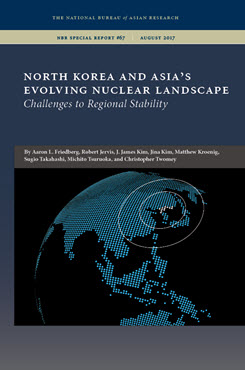North Korea's Nuclear Posture and Its Implications for the U.S.-ROK Alliance
This essay examines the evolution of North Korea’s nuclear and missile program and highlights the political and military implications of this evolving threat for the alliance between the United States and the Republic of Korea (ROK).
EXECUTIVE SUMMARY
This essay examines the evolution of North Korea’s nuclear and missile program and highlights the political and military implications of this evolving threat for the alliance between the U.S. and the Republic of Korea (ROK).
MAIN ARGUMENT
North Korea has institutionalized becoming a nuclear weapons state as its grand strategy and will never give up its program. It is estimated that within a decade the size of North Korea’s nuclear weapons arsenal could be similar to other de facto nuclear weapons states. Pyongyang has also made significant progress in miniaturizing warheads to fit multiple ballistic missiles, while working to develop delivery means that are capable of hiding from surveillance and suitable for launching a surprise attack. North Korea thus aims to undermine U.S. extended deterrence and restrain the ROK military’s response measures. Demonstrating progress in developing second-strike capabilities is a tool of coercive diplomacy. However, the fact that North Korea intentionally exposes every nuclear and missile development tells us that its strategy relies on the balance of threat. That is, North Korea is trying to heighten its nuclear threats to a level that corresponds to the perceived threat from the U.S. The Kim regime will continue to engage in controlled provocations in order to confirm the psychological value of its nuclear weapons capability without triggering a U.S. preemptive strike. As long as North Korea engages in such tests of resolve, the U.S.-ROK alliance should substantially develop tailored deterrence that currently is only at the conceptual level.
POLICY IMPLICATIONS
- The U.S.-ROK alliance should employ greater use of military demonstrations to put pressure on North Korea.
- The international community should strengthen export controls to increase the cost of WMD-related acquisitions and slow down the North’s nuclear armament
- The alliance should develop detailed measures against North Korea’s threat of use, imminent use, and actual use, and consider a comprehensive approach to push for regime transformation.
- Developing strategic communication is important to not cause confusion between acknowledging North Korea’s possession of a nuclear weapons capability and admitting North Korea’s status as a de facto nuclear weapons state.
Jina Kim is an Associate Research Fellow at the Korea Institute for Defense Analyses, where she specializes in U.S.–North Korea relations and nuclear nonproliferation.


